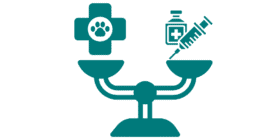Introduction

Navigating the regulatory landscape for veterinary pharmaceuticals and biologics can be complex. The U.S. Food and Drug Administration’s Center for Veterinary Medicine (FDA CVM) and the U.S. Department of Agriculture’s Center for Veterinary Biologics (USDA CVB) oversee different aspects of veterinary product approvals. FDA CVM regulates veterinary drugs under the under the Federal Food, Drug, and Cosmetic Act (FFDCA), whereas USDA CVB regulates products under the Virus-Serum-Toxin Act (VSTA). Jurisdictional determinations are generally based on whether a product meets the definition of a veterinary biologic under VSTA. A Charter for the jurisdiction determination process of the USDA CVB/FDA CVM Jurisdiction Committee was published in December 2024 (https://www.fda.gov/media/184357/download?attachment).
Understanding the distinctions between these two agencies and their regulatory frameworks is crucial for companies developing veterinary drugs and biologics. This blog compares the FDA CVM and USDA CVB approval pathways, explains when a product falls under each jurisdiction, and provides best practices for ensuring compliance.
Comparing FDA CVM and USDA CVB Regulatory Frameworks
FDA Center for Veterinary Medicine (CVM)
FDA CVM regulates veterinary pharmaceuticals, including:
- Prescription and over-the-counter (OTC) drugs for animals.
- Generic and new animal drugs.
- Feed additives and medicated feeds with systemic therapeutic effects.
Key regulatory requirements:
- New Animal Drug Application (NADA): Required for novel drugs demonstrating safety and efficacy.
- Abbreviated New Animal Drug Application (ANADA): For generic veterinary drugs.
- Investigational New Animal Drug Application (INAD): Allows research and testing before full approval.
- Generic Investigational New Animal Drug Application (JINAD): Allows research and testing before full approval of a generic veterinary drug.
- Good Manufacturing Practices (GMPs): Ensures product quality and consistency.
USDA Center for Veterinary Biologics (CVB)
USDA CVB oversees veterinary biologics, including:
- Vaccines.
- Spme monoclonal antibodies and some immunotherapeutics.
- Diagnostic test kits and other diagnostic products of biological origin
Key regulatory requirements:
- Veterinary Biological Product License Application (2003): For initial approval of a new biologic.
- Master Seed and Master Cell Line Approvals: Ensures consistency in biological products.
- Purity, Potency, Safety, and Efficacy Testing: Confirms four main pillars of the VSTA pVeterinary Biologics Establishment License Application (2001): llows an establishment to manufacture and prepare biological products used in animal healthWhen Does a Product Fall Under FDA or USDA Jurisdiction?
Determining whether a product is regulated by FDA CVM or USDA CVB depends on the product’s nature and mechanism of action.
Pharmaceuticals (FDA CVM):
- If the product’s primary mechanism of action is through a chemical reaction, metabolism, or pharmacological effect on or within the animal’s body, it is considered a drug and falls under FDA-CVM jurisdiction. Some examples are;
- Chemically synthesized drugs (e.g., antibiotics, anti-inflammatories, and analgesics).
- Biologics, gene therapy, tissue based products
- Systemic medications designed to treat disease or manage conditions.
Biologics (USDA CVB):
- Product must act primarily through the direct stimulation, supplementation, enhancement, or modulation of the immune system or immune response Some examples are;
- Vaccines (live, killed, or recombinant) designed to stimulate immune response.
- Monoclonal antibodies for cancer, atopy used as alternatives to traditional pharmaceuticals.
- Diagnostic kits for detection of infectious disease pathogens in animals.
Combination Products:
- Some products may contain both drug and biologic components.
- Some biologics can have multiple intended uses/label claims, one or more of which will be USDA CVB regulated and one or more of which will be FDA CVB regulated.
- Companies must consult regulatory agencies to determine the appropriate pathway.
Preparing for Both FDA CVM and USDA CVB Approval Pathways
Companies developing veterinary products must prepare for the specific requirements (e.g, 9CFR or 21CFR) of each regulatory agency. Below are best practices for navigating these pathways.
1. Engage Early with Regulatory Authorities
- Schedule pre-submission meetings with FDA CVM or USDA CVB to clarify approval requirements.
- Seek regulatory guidance on jurisdiction for combination products or where jurisdiction isn’t clear.
2. Develop a Comprehensive Regulatory Strategy
- Outline data requirements for safety, efficacy, and manufacturing processes.
- Align preclinical and clinical study designs with agency expectations.
- Where applicable, address Good Laboratory Practice (GLP) and Good Manufacturing Practice (GMP) compliance early in development.
3. Streamline Manufacturing and Quality Control
- Implement Quality by Design (QbD) approaches to ensure product consistency.
- Validate and/or verify analytical methods to meet FDA or USDA testing standards.
- Maintain documentation for GMP (FDA) or biomanufacturing compliance (USDA).
4. Prepare for Facility Inspections and Compliance Audits
- Ensure manufacturing facilities comply with FDA or USDA regulatory requirements.
- Conduct internal audits and mock inspections to address potential compliance gaps.
- Establish post-approval monitoring and pharmacovigilance programs.
How DSI Helps Companies Navigate Dual Regulatory Environments
DSI provides expert guidance in:
- Regulatory Strategy Development: Helping companies determine whether FDA CVM or USDA CVB regulations apply.
- CMC and Quality Compliance: Assisting with Chemistry, Manufacturing, and Controls (CMC) or USDA biologics manufacturing documentation and facility compliance.
- Pre-Submission and Dossier Preparation: Ensuring accurate and complete regulatory submissions.
- Post-Market Compliance and Lifecycle Management: Supporting ongoing regulatory compliance and product updates.
Conclusion
Understanding the differences between FDA CVM and USDA CVB is essential for companies developing veterinary pharmaceuticals and biologics. By proactively engaging with regulators, implementing robust quality systems, and streamlining the regulatory approval process, companies can successfully bring their veterinary products to market.




